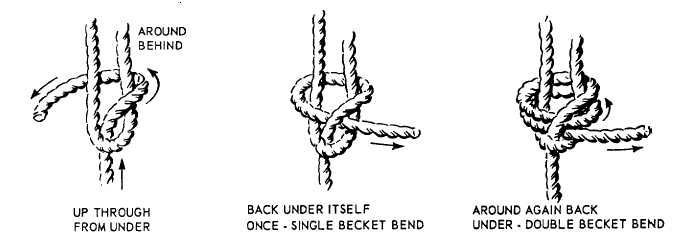| |
Figure 3-12.–Square knot.
Figure 3-13.–Tying single and double becket bends.
The bowline is a good knot with many uses. It is
the best known knot for bending two lines together.
used whenever a loop is needed, such as in making a
However, it can jam on a strain and become very
temporary eye in a mooring line.
difficult to untie.
You must know which knot or splice will serve best
in different circumstances such as tying up to a mooring
or dock, rigging aloft or over the side during painting,
and highline transfer during replenishment.
In the small group of knots described in this section,
you will find every knot you will need around the decks,
together with an idea of the uses to which each may be
put. You should make every effort to learn them.
According to a Seaman's use of the term knot, the
line usually is bent to itself. The knot forms an eye or
knob or secures a cord or line around an object, such as
a package.
For a square knot, both parts of the line must be
under the same bight. If one part is up and the other part
is down, you have a granny knot, which is of no use to
any seaman. Figure 3-12 shows how to get a square knot
every time.
Here is the proper procedure for tying a square
knot: Take the end in your right hand, say to yourself,
“over-under,” and pass it over and under the part in
your left hand, as shown. With your right hand take the
end that was in your left, say to yourself this time,
“under-over,” and pass it under and over the part in
your left hand.
A bend ordinarily is used to join two lines
together. The square knot, also called the reef knot, is
A becket bend, is especially good for bending
together two lines of different sizes. Figure 3-13 details
3-11
|

